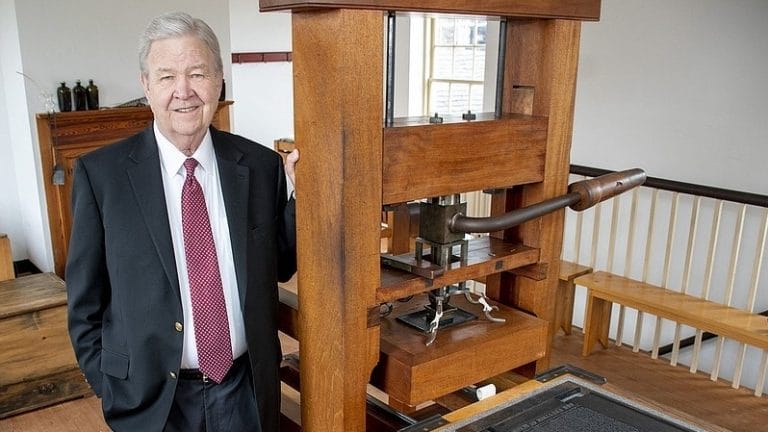

This feature originally appeared in the Arkansas Democrat Gazette’s High Profile section on December 26, 2021.
Fifty years? Who serves on a state commission for 50 years?
That would be Gordon Rather Jr., a lawyer at Wright Lindsey and Jennings, who has served on the Historic Arkansas Museum Commission since Oct. 26, 1971.
“The mission of the museum is to preserve Arkansas’ rich history for future generations. Anything that I can do to preserve our remarkable heritage is something that I’m proud to participate in,” says Rather, who has been the commission’s secretary for as long as he can remember.
In honor of his five decades of service, the museum recently named its exhibit and educational space in the Woodruff Print Shop annex in his honor. The print shop is especially significant to Rather — he is William E. Woodruff’s great-great-grandson.
Best known as the founder of the Arkansas Gazette, the state’s first newspaper, Woodruff became one of the state’s most important and colorful historical figures through his other business interests, political connections, and efforts to promote Arkansas, according to the Encyclopedia of Arkansas.
Rather was asked to join the commission by Ed Cromwell, an architect and family friend who knew of Rather’s connection to Woodruff. Cromwell died in 2001.
“I have to think that is true,” Rather says when asked if he was asked to serve on the commission because of the family connection to Woodruff. “I don’t know that Mr. Cromwell ever said that, but as years have gone by, I thought to myself that had to be one of the reasons that at age 32 and just barely getting started in my law practice, Mr. Cromwell and the other commissioners would invite me to join them on the commission.”
A replica of the Woodruff Print Shop is located on the grounds of the museum.
“The print shop is carefully reconstructed to be as authentic as possible. It was originally located in that area and when we decided to build the Woodruff Print Shop, we carefully researched the bricks, the glass panes, the nails, all of the materials that would have been in the original structure, and all of those were reproduced. So that while it is a new building, it’s as authentic as we could possibly make it — right down to the nails that were used in the construction,” Rather says.
Rather is likely the longest-serving member of any state board or commission. The Historic Arkansas Museum Commission is the only state board or commission that is self perpetuating, Rather says. When the commission was created in the 1930s, the bylaws called for up to 11 members who are allowed to appoint new members to an unlimited number of years of service.
For many years, the commission had a mock-up of what it wanted the museum to look like. Rather credits U.S. Rep. French Hill with making that dream a reality.
“We wanted the historic structures that are there and we wanted a reception area that had gallery space to show off our collection and have exhibits and also to have a place where people could come and gather.
“I give French Hill complete credit for bringing that to reality because when he became a commissioner, he had the political and financial connections to turn our dream into more than just a mock-up under a Plexiglas cover,” he says. “Not long after French Hill became a commissioner, Gov. [Mike] Huckabee was breaking ground for our reception center that we have today.”
Hill was on the commission from 1994-2014 when he gave up his seat after being elected to Congress.
“Gordon’s commitment to historic preservation and telling the story of early Arkansas and her people will benefit generations to come.” Hill says. “He is a model civic leader.”
In addition to what is on public display, Rather pointed out that the museum has a “vast collection of Arkansas material culture — portraits, photographs, furniture, pottery.” Much of the collection can be found in two editions of “Arkansas Made.” The second edition of “Arkansas Made” was recently published in two volumes.
“The ‘Arkansas Made’ publications are a culmination of the Historic Arkansas Museum’s exhaustive investigation into the history of our state’s material culture,” he says.
When asked about what he would like to see in the future for the Arkansas Historic Museum, Rather repeats something Huckabee said at the ground-breaking ceremony for the reception: “History is to a civilization what memory is to an individual.”
“And if you take that to heart — and I would like to think everybody on our commission has taken that to heart — I think that helps guide us in our visions of the future,” Rather says. “That was the first time I have ever heard anyone say those words. Obviously it made an impression on me.”
Rather says serving on a state commission is “almost a family tradition.” His wife, Hayden, has served on the MacArthur Museum of Arkansas Military History for six years.
So why has Rather been willing to serve on a commission for five decades?
“Well, the truth of the matter is, I’ve never regarded that as any kind of a burden,” he says. “It’s been an honor and a privilege for me to be associated with the people who are on the commission. And it’s given me a great deal of pleasure. It’s been very rewarding and fulfilling.”
Historic Arkansas Museum is at 200 E. Third St. in Little Rock. It is open from 9 a.m. to 5 p.m. Tuesdays through Saturdays and 1 to 5 p.m. Sundays. Admission to the galleries is free.










































































